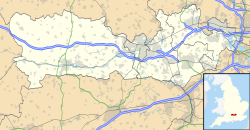| Pangbourne | |
|---|---|
| Village and civil parish | |
 Pangbourne village centre | |
Location within Berkshire | |
| Area | 6.8 km2 (2.6 sq mi) |
| Population | 3,277 (2021 census) |
| • Density | 482/km2 (1,250/sq mi) |
| OS grid reference | SU6376 |
| Civil parish |
|
| Unitary authority | |
| Ceremonial county | |
| Region | |
| Country | England |
| Sovereign state | United Kingdom |
| Post town | Reading |
| Postcode district | RG8 |
| Dialling code | 0118 |
| Police | Thames Valley |
| Fire | Royal Berkshire |
| Ambulance | South Central |
| UK Parliament | |
Pangbourne is a village and civil parish on the River Thames in the West Berkshire unitary area of the county of Berkshire, England. Pangbourne has shops, churches, schools and a village hall. Outside its grouped developed area is an independent school, Pangbourne College.





